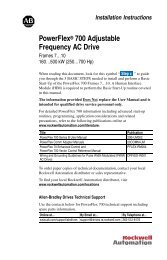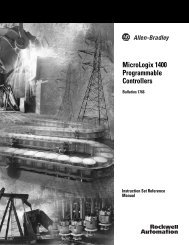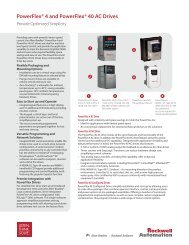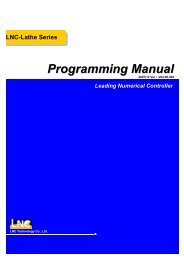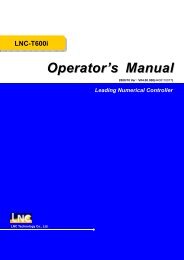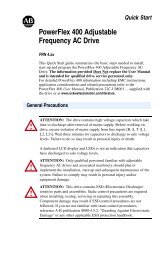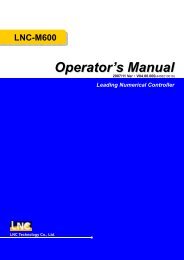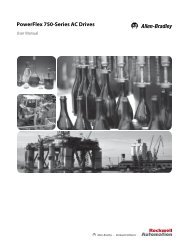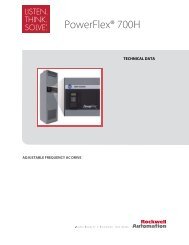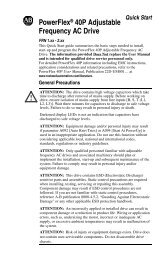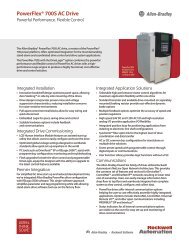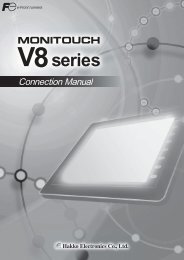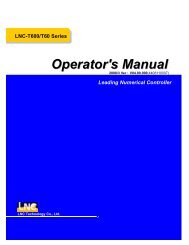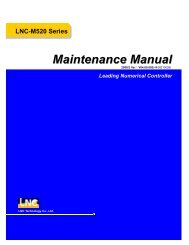- Page 1 and 2:
Maximum Value for OEMs SM CSDP Plus
- Page 3 and 4:
Contents 1. Introduction...........
- Page 5 and 6:
SEt-32 Brake Inactive Delay Time Af
- Page 7 and 8:
A brief introduction to the manual
- Page 9 and 10:
1 Introduction Functionality CSDP P
- Page 11 and 12:
The models with the same appearance
- Page 13 and 14:
The performance specifications of C
- Page 15:
Input Voltage B stands for 220V AC.
- Page 18 and 19:
Please do not put stress on the ele
- Page 20 and 21:
Servo Drive Installation Please che
- Page 22 and 23:
Please follow the command below to
- Page 24 and 25:
Wiring Specifications Signal line I
- Page 26 and 27:
CN1 CN2 Connect the single-phase vo
- Page 28 and 29:
Connection with Controller Connect
- Page 30 and 31:
32 Higher Control Connector (CN1) C
- Page 32 and 33: Please See "Cable Specifications" i
- Page 34 and 35: Encoder Connector Specifications Mo
- Page 36 and 37: Grounding, Wiring Please separate t
- Page 39 and 40: 3 Operation Overview You can instan
- Page 41 and 42: For instance, if you want to set up
- Page 43 and 44: If the revolution speed of the moto
- Page 45 and 46: Monitor Number List No. Contents (U
- Page 47 and 48: Jog Operation The revolution will c
- Page 49 and 50: Current Offset Adjustment To adjust
- Page 51 and 52: Parameter Initialization To return
- Page 53 and 54: SEt-51 Set-up Value Please select t
- Page 55 and 56: 4 Control Overview Input signal is
- Page 57 and 58: For instance, put 7 in the fourth d
- Page 59 and 60: Three types of command are inputed
- Page 61 and 62: Please select the position control
- Page 63 and 64: The speed reduction ratio is the ra
- Page 65 and 66: If the distance to move with one pu
- Page 67 and 68: Position Error Range Set the positi
- Page 69 and 70: Speed Command Speed Control Wiring
- Page 71 and 72: If the CN1 connector pins where the
- Page 73 and 74: Torque Control Torque control mode
- Page 75 and 76: If the torque command gain is 100%/
- Page 77 and 78: Multi-level Speed Control Multi-lev
- Page 79 and 80: Multi-level Speed Speed Parameter D
- Page 81: Combination Control Position contro
- Page 85 and 86: If position-related gains alone are
- Page 87 and 88: Setting Tuning Coefficient on onlin
- Page 89 and 90: Please set torque command filter at
- Page 91 and 92: To set up position control-related
- Page 93 and 94: P/PI Mode Set-up Function By settin
- Page 95 and 96: Set Value 0 Do not use P/PI mode sh
- Page 97 and 98: The set-up sequence of the default
- Page 99 and 100: 6 Application Motor Stop The servo
- Page 101 and 102: When the motor needs to stop during
- Page 103 and 104: Please set the brake output waiting
- Page 105 and 106: Regenerative Resistor When the oper
- Page 107 and 108: This picture shows the case where a
- Page 109 and 110: K M ( EL + ER + EC ) EG E = E − +
- Page 111 and 112: As shown below, executing command i
- Page 113 and 114: Speed Limiting Method Selection Ple
- Page 115 and 116: Even when the motor is revolving at
- Page 117 and 118: Absolute Encoder An absolute encode
- Page 119 and 120: For the controller that can’t rec
- Page 121 and 122: 7 Troubleshooting Check Checking Mo
- Page 123 and 124: If the voltage of the external batt
- Page 125 and 126: The servo drive can notify the cont
- Page 127 and 128: If the encoder cable is not connect
- Page 129 and 130: If there is an error with the memor
- Page 131 and 132: Appendix A Parameter ATTENTION To c
- Page 133 and 134:
SEt-03 Speed Loop Integral Gain •
- Page 135 and 136:
SEt-07 Position Feedforward Filter
- Page 137 and 138:
SEt-11 Reverse Internal Torque Limi
- Page 139 and 140:
SEt-17 Zero Clamp Level • Setting
- Page 141 and 142:
SEt-20 Deceleration Time • Settin
- Page 143 and 144:
SEt-23 Encoder Output Ratio Numerat
- Page 145 and 146:
SEt-26 Internal Speed Command 1 Int
- Page 147 and 148:
ATTENTION The brake mounted on the
- Page 149 and 150:
SEt-33 Following Error Level • Se
- Page 151 and 152:
SEt-37 Electronic Gear Ratio Denomi
- Page 153 and 154:
SEt-42 System Gain • Setting rang
- Page 155 and 156:
SEt-44(1) Dynamic Brake • Setting
- Page 157 and 158:
SEt-44(4) Encoder Output Pulse Dire
- Page 159 and 160:
Forward direction is counterclockwi
- Page 161 and 162:
Open Collector Input SEt-46(4) Spee
- Page 163 and 164:
When the second digit of SEt-50 is
- Page 165 and 166:
SEt-53 Motor Capacity • Setting r
- Page 167 and 168:
SEt-57 Position Error for Speed Int
- Page 169 and 170:
Put 3 in the second digit of SEt-62
- Page 171 and 172:
ATTENTION If inertia ratio is set,
- Page 173 and 174:
SEt-75 Overload Curve Level • Set
- Page 175 and 176:
SEt-79 Internal Speed Command 4 •
- Page 177 and 178:
Appendix B Motor Specifications CSM
- Page 179 and 180:
Speed Torque Curve 181
- Page 181 and 182:
CSMS Motor Specifications CSMS Moto
- Page 183 and 184:
Speed Torque Curve 185
- Page 185 and 186:
CSMH Motor Specifications CSMH Moto
- Page 187 and 188:
189
- Page 189 and 190:
Item Specifications Item Specificat
- Page 191 and 192:
CSMK Motor Specifications CSMK Moto
- Page 193 and 194:
195
- Page 195 and 196:
Brake Specifications RSMD Motor Bra
- Page 197 and 198:
RSMS Motor Specifications RSMS Moto
- Page 199 and 200:
RSMH Motor Specifications RSMH Moto
- Page 201 and 202:
203
- Page 203 and 204:
Brake Specifications RSMF Motor Bra
- Page 205 and 206:
RSMK Motor Specifications RSMK Moto
- Page 207 and 208:
209
- Page 209 and 210:
Brake Specifications RSML Motor Bra
- Page 211 and 212:
RSMN Motor Specifications RSMN Moto
- Page 213 and 214:
RSMX Motor Specifications RSMX Moto
- Page 215 and 216:
217
- Page 217 and 218:
Model LL Brake Present Brake Absent
- Page 219 and 220:
RSMD, RSMF, RSMH, RSMK, RSML, RSMS
- Page 221 and 222:
Shaft End Size CSM Series Motor Sha
- Page 223 and 224:
Appendix C Cable Specifications Mot
- Page 225 and 226:
Encoder Cable CSMD, CSMF, CSMH, CSM
- Page 227 and 228:
I/O Cable CON-SCONN50PIN cable is u
- Page 229 and 230:
Motor Brake Cable CSMD, CSMF, CSMH,
- Page 231 and 232:
Appendix D Load Calculation ROLL Lo
- Page 233 and 234:
Minimum Acceleration Time (s) Minim
- Page 235 and 236:
Load Inertia Moment (kg . m 2 ) Min
- Page 237 and 238:
Movement Amount (m) Vl 2t s−ta
- Page 239 and 240:
Vertical BALL SCREW Load Mechanical
- Page 241 and 242:
Acceleration Torque Required (N . m
- Page 243 and 244:
Load Inertia Moment (kg . m 2 ) Min
- Page 245 and 246:
Disk Load Mechanical Configuration
- Page 247 and 248:
Index Sign /ABS-DT 4-58, 6-121, A-1
- Page 249 and 250:
Jog Operation Speed A-146 L Label 1
- Page 251 and 252:
Speed Bias Standard Range 5-85, 5-9
- Page 254:
CSDP Plus Servo Drive User Manual O



